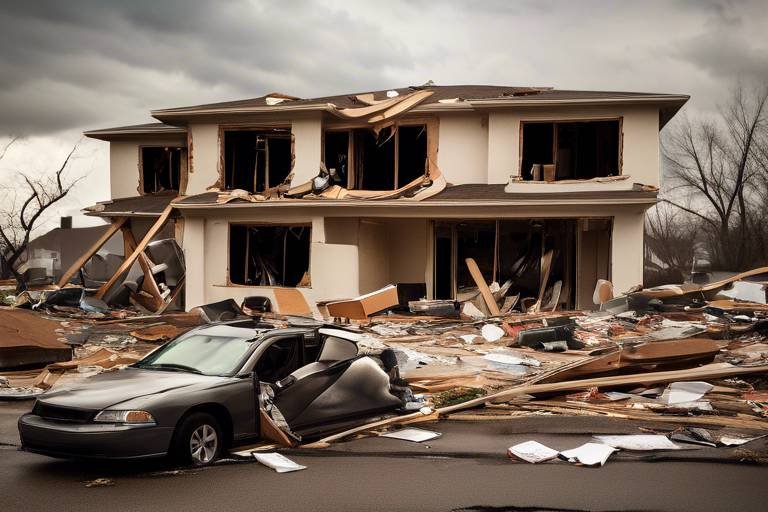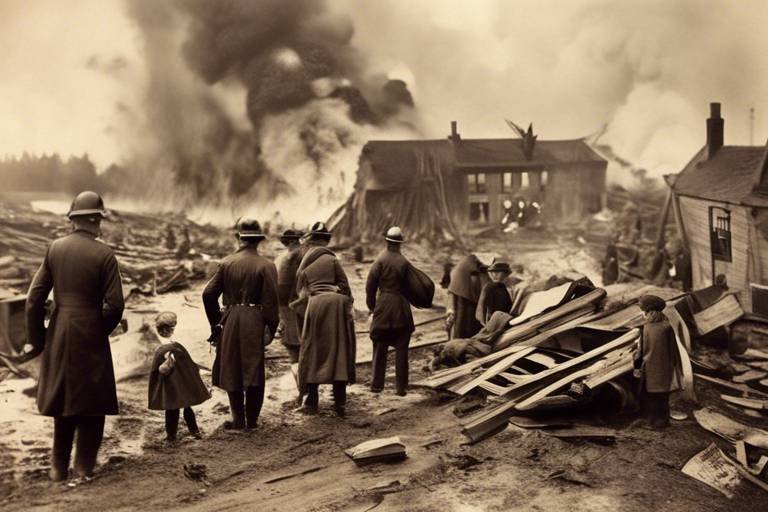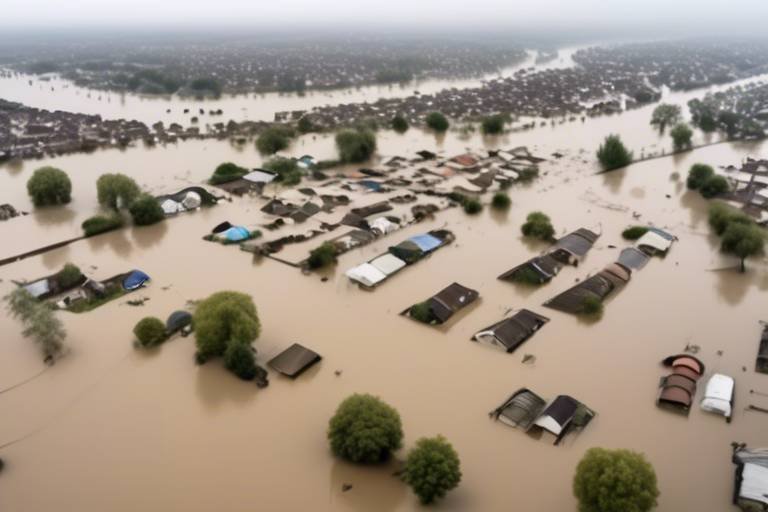How to Convert Your Basement into a Safe Shelter
In today's unpredictable world, having a safe space in your home can provide peace of mind. Converting your basement into a secure shelter is not only a practical solution but also a project that can be both rewarding and fulfilling. Imagine a cozy retreat that doubles as a protective haven during emergencies! This article will guide you through the entire process, from assessing your basement's suitability to stocking it with essential supplies. So, roll up your sleeves and get ready to transform that underutilized space into a fortress of safety.
Before you dive headfirst into the conversion process, it's essential to take a step back and evaluate your basement's structure. Is it dry and well-ventilated? Do you notice any signs of moisture or mold? These factors are crucial in determining whether your basement can be transformed into a safe shelter. Consider the following:
- Structure Integrity: Inspect the walls and foundation for cracks or weaknesses.
- Moisture Levels: Use a moisture meter to check for dampness.
- Accessibility: Ensure your basement can be easily accessed in an emergency.
By carefully assessing these elements, you can ensure that your basement has the potential to become a secure refuge.
A well-thought-out layout is essential for functionality and safety. Think about how you want to use the space. Will it be just for shelter, or do you want to include a living area? Consider optimal space allocation, entry points, and areas for storage and utilities. For instance, you might want to designate specific areas for sleeping, cooking, and storing supplies. This way, everything has its place, making it easier to find what you need in a pinch.
Establishing a secure and accessible entry point is vital. This entry should be designed to withstand emergencies, such as severe weather or intrusions. A well-constructed access route can make all the difference. Consider installing a sturdy staircase or a retractable ladder, depending on your basement's layout. Remember, the goal is to make it easy to get in and out quickly when it matters most.
When it comes to safety, selecting a sturdy door is key. You want something that can withstand external threats while providing you with peace of mind. Explore various materials such as steel or reinforced wood, which offer maximum protection. Additionally, ensure the door has a reliable locking mechanism. A well-chosen door can be your first line of defense.
Having alternative exit routes is crucial for safety. You never know when you might need a quick escape. Consider creative solutions for emergency exits, such as:
- Installing a secondary door that leads to the outside.
- Creating a window that can be easily opened from the inside.
- Ensuring that all exits are clearly marked and easily accessible.
These options can provide peace of mind, knowing you have multiple ways to exit if needed.
Proper ventilation is essential for maintaining air quality in your shelter. Stale air can lead to discomfort and health issues, so it's crucial to have a system in place that ensures fresh air circulation while keeping contaminants out. Consider installing vents or using air purifiers to maintain a healthy environment. A well-ventilated shelter can make a world of difference in how you feel during an emergency.
Preventing water intrusion is critical for a safe shelter. Water can compromise your supplies and create a hazardous environment. This section discusses effective waterproofing techniques and moisture control methods to protect your space. Start by identifying potential problem areas, such as cracks in the foundation or gaps around windows. Sealing these areas can significantly reduce the risk of water damage.
Identifying and sealing cracks is a fundamental step. Use a high-quality sealant to fill in any gaps you find. Regular inspections are essential, as even small openings can lead to significant issues over time. By proactively sealing these cracks, you're taking a vital step in ensuring your shelter remains dry and safe.
A sump pump can be a lifesaver in flood situations. If your basement is prone to flooding, installing a sump pump is a smart move. This device helps to remove excess water, keeping your shelter dry. Make sure to regularly check and maintain the sump pump to ensure optimal performance when you need it the most.
Stocking your shelter with essential supplies is vital. You never know when an emergency might strike, so it's best to be prepared. Here are some must-have items to consider:
- Non-perishable food items: Canned goods, dried fruits, and nuts.
- Water: Store at least one gallon per person per day.
- First aid kit: Include bandages, antiseptics, and any necessary medications.
Organizing these supplies effectively can make it easy to grab what you need in an emergency. Consider using clear bins or labeled containers to keep everything in order.
Proper food and water storage is crucial for long-term survival. Explore strategies for selecting, storing, and rotating supplies to ensure freshness. Make it a habit to check expiration dates and replace items as needed. This way, you can be confident that your emergency supplies are always ready when you need them.
Having a well-stocked first aid kit can make a significant difference in emergencies. Essential medical supplies to include in your shelter are:
- Adhesive bandages in various sizes
- Gauze pads and tape
- Antibiotic ointment
- Prescription medications
Regularly review and update your first aid kit to ensure you have everything necessary to handle minor injuries and health issues.
Q1: How much does it cost to convert a basement into a shelter?
A1: The cost can vary widely depending on the size of your basement, the materials used, and the extent of the modifications. It's best to create a budget and get quotes from contractors if you're not DIY-ing.
Q2: Can I use my basement for other purposes besides a shelter?
A2: Absolutely! With the right design, your basement can serve multiple purposes, such as a recreational room or home office, while still being a safe shelter in emergencies.
Q3: How often should I check my emergency supplies?
A3: It's a good idea to check your supplies at least twice a year. This ensures that food is fresh, water is clean, and your first aid kit is stocked.

Assessing Your Basement's Suitability
Before diving headfirst into the exciting project of converting your basement into a safe shelter, it's absolutely essential to take a moment and assess its suitability. Think of this step as the foundation of your fortress; without a solid base, even the most elaborate plans can come crashing down. Start by examining the structure of your basement. Is it sturdy? Are there any visible signs of damage, such as cracks in the walls or sagging ceilings? These structural issues could compromise the safety of your shelter, so addressing them early on is crucial.
Next, consider the moisture levels in your basement. A damp environment can turn your safe haven into a breeding ground for mold and mildew, which can pose serious health risks. Use a moisture meter to check the humidity levels. Ideally, you want to keep the relative humidity below 60%. If your basement feels musty or you notice water stains on the walls, it’s a red flag. You may need to invest in waterproofing solutions before proceeding with your conversion.
Accessibility is another vital factor. Your shelter should be easy to access, especially during emergencies. Are there any obstacles that could hinder a quick escape? Consider the layout of your home and how easily you can get to the basement. A clear path is essential, so remove any clutter that might block your way. Additionally, think about how you’ll get in and out during different weather conditions. A slippery staircase can turn a safe exit into a dangerous situation.
To help you visualize the key factors in assessing your basement's suitability, here’s a quick checklist:
- Structural Integrity: Check for cracks, sagging, or any signs of damage.
- Moisture Levels: Use a moisture meter and address any dampness.
- Accessibility: Ensure clear pathways and consider weather conditions.
Once you've evaluated these aspects, you’ll have a clearer understanding of your basement's potential as a safe shelter. Remember, this is not just about creating a cozy space; it's about ensuring that this shelter can withstand unexpected emergencies. Taking the time to assess your basement thoroughly will pay off in the long run, providing peace of mind and a safe haven when you need it the most.
Q: How do I know if my basement is structurally sound?
A: Look for visible cracks, signs of water damage, and consult a structural engineer if you're unsure.
Q: What moisture levels are considered safe for a basement?
A: Aim for a relative humidity level below 60% to prevent mold growth.
Q: How can I improve accessibility to my basement?
A: Clear any clutter, ensure proper lighting, and consider installing handrails for safety.

Designing Your Shelter Layout
When it comes to converting your basement into a safe shelter, designing an effective layout is a critical step that can make all the difference in functionality and safety. Think of your shelter as a well-oiled machine; every part needs to work together seamlessly. You want to ensure that the space is not only comfortable but also practical in times of emergency. So, where do you start?
First and foremost, consider the optimal space allocation. You'll want to divide your basement into specific zones that serve different purposes. For instance, designate areas for sleeping, storing supplies, and even a small workspace if needed. This way, you can quickly access what you need without fumbling around in a panic. Imagine trying to find a flashlight in the dark; having everything organized will save you precious time.
Next, think about the entry points. Your shelter should have at least one main access route that is secure and easy to navigate. Ideally, this entry should be sturdy and well-marked. If you have more than one entry point, make sure they are all easily accessible and not obstructed by furniture or other items. In case of an emergency, you want to be able to get in and out quickly without any obstacles.
Establishing a secure and accessible entry point is vital for your shelter's overall safety. This means not only having a solid door but also ensuring that the path leading to it is clear and well-lit. Consider adding emergency lighting that activates during power outages, guiding you safely to the exit. The goal is to make sure that anyone using the shelter can find their way in and out without confusion.
When it comes to doors, selecting the right material is key. Steel doors are often recommended for their durability and resistance to forced entry. You might also consider reinforced doors with deadbolts for added security. Don’t forget about the weatherstripping; it helps keep moisture out, which is crucial for maintaining a dry environment inside your shelter.
Having alternative exit routes is crucial for safety. In an emergency, you may need to evacuate quickly, and relying solely on one exit can be risky. Think creatively about how to incorporate additional exits. For example, if your basement has windows that are big enough, consider installing escape ladders. This way, if the main door is blocked, you have a backup plan. Ensure that these exits are also clearly marked and easily accessible.
Let's not overlook the importance of ventilation. A basement can easily become stuffy, especially if it’s sealed off for an extended period. Installing a proper ventilation system is essential to ensure fresh air circulation. You can achieve this by using exhaust fans or even small windows that can be opened. Just remember, while you want fresh air, you also want to keep contaminants out, so consider air filters to improve air quality.
In summary, designing your shelter layout is about creating a space that is both functional and safe. By considering the optimal allocation of space, ensuring secure entry points, and maintaining good air quality, you’ll be well on your way to having a reliable shelter that can withstand emergencies.
- How do I ensure my basement is waterproof? - Regularly inspect for cracks and use sealants or waterproofing membranes to prevent water intrusion.
- What should I include in my emergency supplies? - Essentials like food, water, a first aid kit, and a flashlight are crucial.
- How can I improve air quality in my shelter? - Install ventilation systems and use air filters to keep the air fresh.

Creating a Safe Entry Point
When it comes to transforming your basement into a secure shelter, one of the most critical aspects is establishing a safe entry point. This entry point not only serves as your main access to the shelter but also needs to be robust enough to withstand potential emergencies. Imagine it as the fortress door that stands between you and the unpredictable world outside. So, how do you ensure that your entry point is both secure and accessible?
First, consider the location of your entry point. It should be easily reachable, yet discreet enough to avoid drawing unwanted attention. Ideally, the access should be through a sturdy staircase that leads directly to your basement. This not only provides easy access but also ensures that you can quickly retreat to safety when needed. Think of it as a secret passageway—one that is hidden in plain sight but always ready for action.
Next, let’s talk about the door itself. The door to your shelter should be made of high-quality materials that can withstand physical force and environmental challenges. Here are some options to consider:
- Steel Doors: These are incredibly durable and resistant to impact.
- Fiberglass Doors: They offer excellent insulation and are less prone to warping.
- Wooden Doors: If you prefer aesthetics, ensure they are solid-core and reinforced.
In addition to the material, the locking mechanism is equally important. Opt for a deadbolt lock rather than a standard knob lock. Deadbolts provide an extra layer of security, making it much harder for intruders to gain access. You might also want to consider installing a smart lock that allows you to control access remotely, adding convenience to your security measures.
Emergency situations can be unpredictable, which is why having multiple exit options is crucial. This could mean installing an additional door or even a window that can act as an escape route in case your primary entry point is compromised. Think of it as having a backup parachute; you hope you never need it, but it’s comforting to know it’s there. Consider these options for emergency exits:
- Installing a window well that allows for easy egress.
- Creating a secondary door that leads to the outside.
- Ensuring that any exit routes are kept clear of obstructions.
Lastly, don’t overlook the importance of lighting around your entry point. Adequate lighting can deter potential threats and help you navigate in low visibility situations. Motion-sensor lights are a fantastic option, as they automatically activate when someone approaches, providing both security and convenience. Think of it as having your own personal spotlight—ready to shine when you need it most.
In summary, creating a safe entry point is about more than just a door; it's about building a secure gateway to your protective space. By carefully considering the location, materials, locking mechanisms, and additional exit routes, you can ensure that your basement shelter is not just a refuge, but a truly safe haven.
Q: What type of door is best for a basement shelter?
A: Steel doors are often the best choice for security due to their durability. Fiberglass doors are also a great option for insulation and resistance to warping.
Q: How can I ensure my entry point is accessible during an emergency?
A: Keep pathways clear and consider installing a secondary exit route, such as a window well or another door, to ensure quick evacuation if necessary.
Q: Is lighting really necessary around the entry point?
A: Yes! Adequate lighting not only deters intruders but also helps you navigate safely in low visibility situations.

Choosing the Right Door
When it comes to transforming your basement into a safe shelter, one of the most critical components is undoubtedly the door. Think of the door as the **guardian** of your sanctuary; it needs to be strong enough to withstand external threats while also providing easy access for you and your loved ones. So, what should you look for when choosing the right door? Let's break it down!
First and foremost, you want to consider the **material** of the door. Steel doors are often hailed as the gold standard for security. They are incredibly durable and can resist forced entry better than wooden doors. However, if you're leaning towards aesthetics, fiberglass doors can offer both beauty and strength, making them a popular choice for many homeowners. Remember, the door should not only protect but also blend seamlessly with your basement's design.
Next, pay attention to the **frame**. A sturdy door is only as secure as its frame. Opt for a door frame made of solid wood or metal that can withstand pressure. Additionally, ensure that the door is fitted with a **deadbolt lock**. This is a simple yet effective way to enhance security. A deadbolt adds an extra layer of protection that a standard lock simply can't provide. You wouldn’t want to compromise on safety, right?
Another factor to consider is **weatherproofing**. Your basement may be a safe haven, but it shouldn't become a damp one! Look for doors that are specifically designed to repel moisture. This will not only keep your shelter dry but also prevent mold and mildew from becoming unwelcome guests. If you're unsure, consult with a professional to find the best options available.
Lastly, don't forget about the **accessibility** of the door. In an emergency, you want to ensure that everyone can get in and out quickly. A door that swings outward might be more practical in a crisis, as it allows for a quicker exit. Additionally, consider installing a secondary lock that can be easily opened from the inside to facilitate a rapid evacuation if necessary.
In summary, choosing the right door for your basement shelter involves considering various factors, including material, frame strength, weatherproofing, and accessibility. Each of these elements plays a vital role in ensuring that your basement remains a safe haven during emergencies. After all, the door is your first line of defense, so make sure it’s up to the task!
- What type of door is best for a basement shelter? Steel doors are highly recommended for their durability and security features.
- How can I ensure my door is weatherproof? Look for doors specifically designed to resist moisture and consider adding weather stripping.
- Is a deadbolt lock necessary? Yes, a deadbolt lock significantly enhances the security of your door.
- What should I do if my door is hard to open? Check for any obstructions, and consider lubricating the hinges or consulting a professional for repairs.

Emergency Exit Options
When it comes to safety, having a reliable emergency exit is like having a lifeline in a storm. You never know when you might need to make a hasty exit from your basement shelter, whether it's due to a natural disaster, a fire, or any unforeseen circumstance. That's why planning for multiple exit routes is essential. Imagine being in a situation where your only escape route is blocked; panic can set in quickly. So, let's explore some effective options for emergency exits that not only ensure safety but also provide peace of mind.
First and foremost, consider installing a window well exit. This option allows you to create an escape route through a basement window. Make sure the window is large enough to crawl through and is equipped with a durable window well that can be easily accessed. Adding a ladder or steps leading up to the ground level can significantly enhance accessibility. You wouldn't want to find yourself struggling to climb out in a moment of urgency, right?
Another viable option is to create a secondary door that leads directly outside. This door should be solid and secure, ideally reinforced to withstand external pressures. You can position it on the opposite side of your primary entrance to provide a backup route. Think of it as a secret passage that opens up new possibilities in a crisis. Just remember to keep the pathway clear and unobstructed at all times!
In addition to these physical exits, consider the importance of signage. Clear signs indicating emergency exit routes can guide you and your family in the dark or during high-stress situations. You can even create a simple map of your basement layout, marking all exit points and ensuring everyone knows the quickest way out. It’s like having a treasure map, but instead of gold, you’re seeking safety!
Finally, don't forget about regular drills. Just like fire drills at school, practicing your emergency exit routes can make a world of difference. Conducting these drills will help everyone feel more comfortable and prepared should the need arise. You can even time the drills to see how quickly everyone can evacuate, turning it into a fun family challenge!
In summary, having multiple emergency exit options is crucial for your basement shelter's safety. Whether it's a window well, a secondary door, clear signage, or regular drills, each element contributes to a comprehensive safety plan. Remember, the goal is to ensure that everyone can exit swiftly and safely, no matter the circumstances.
- What should I do if my basement has no windows? If your basement lacks windows, ensure you have a secure secondary door that leads outside. Consider installing a window well if possible.
- How often should I conduct emergency drills? It's advisable to conduct emergency drills at least twice a year to keep everyone familiar with the escape routes.
- Should I have a flashlight near my exits? Yes! Keeping a flashlight near your exits can help illuminate the way during power outages or emergencies.

Ventilation and Air Quality
When converting your basement into a safe shelter, are paramount. You might be wondering, why is this even important? Imagine being trapped in a confined space without fresh air; it can feel suffocating and disorienting. Proper ventilation ensures that your shelter remains a breathable and comfortable environment, keeping harmful contaminants at bay while allowing fresh air to circulate.
First off, let's talk about the types of ventilation systems you can implement. There are two main categories: natural and mechanical ventilation. Natural ventilation relies on openings, like windows or vents, to facilitate airflow. While this method is cost-effective and energy-efficient, it might not be reliable during extreme weather conditions. On the other hand, mechanical ventilation uses fans and ducts to actively circulate air, providing a consistent flow regardless of the outside conditions. This is especially crucial during emergencies when you need air quality to be top-notch.
Another critical aspect to consider is the air filtration system. You want to ensure that the air circulating in your shelter is as clean as possible. Installing a high-quality air filter can help remove dust, allergens, and other pollutants. Look for filters with a HEPA rating, which stands for High-Efficiency Particulate Air. These filters can trap 99.97% of particles that are 0.3 microns or larger, making them ideal for maintaining a healthy environment.
For optimal air quality, consider incorporating air purifiers into your shelter setup. These devices can significantly reduce indoor air pollutants and allergens, providing an additional layer of protection. When selecting an air purifier, pay attention to its Clean Air Delivery Rate (CADR) to ensure it meets your shelter's size and needs.
Moreover, don't forget about humidity control. Excess moisture can lead to mold growth, which poses serious health risks. A dehumidifier can be a lifesaver in keeping humidity levels in check. Aim for a humidity level between 30% and 50% for optimal comfort and safety. You can also monitor humidity levels using a hygrometer, which is a simple yet effective tool for tracking moisture levels in your shelter.
In summary, ensuring proper ventilation and maintaining air quality in your basement shelter is not just a matter of comfort; it’s a fundamental aspect of safety. By investing in the right systems and equipment, you can create a space that is not only secure but also healthy. Remember, a well-ventilated shelter can be the difference between feeling trapped and feeling safe during emergencies.
- How often should I check my ventilation system? It's advisable to inspect your ventilation system at least twice a year to ensure it's functioning correctly.
- Can I use my basement as a shelter without a ventilation system? While it's possible, it's not recommended. Lack of ventilation can lead to poor air quality, which may be hazardous.
- What are signs that I need to improve my basement's air quality? Look for signs like musty odors, visible mold, or excessive humidity. These indicate that your air quality may be compromised.

Waterproofing and Moisture Control
When it comes to transforming your basement into a safe shelter, waterproofing and moisture control are not just afterthoughts; they are the foundation of your safety and comfort. Imagine this: you’ve created a cozy hideaway, stocked it with supplies, and then, out of nowhere, a heavy rainstorm hits, flooding your sanctuary. To prevent such a nightmare, you need to take proactive measures to ensure your basement remains dry and secure.
First things first, assess the current state of your basement. Look for any signs of moisture, such as damp spots on the walls, a musty smell, or even mold growth. These indicators are like red flags waving at you, signaling that your basement needs some serious attention. You can start by checking the foundation and walls for cracks and gaps that might allow water to seep in. Remember, even the tiniest crack can lead to significant water intrusion over time.
Once you've identified potential problem areas, it's time to seal them up. Sealing cracks and gaps is a fundamental step in waterproofing your basement. Use a high-quality waterproof sealant to fill in these openings, ensuring a tight barrier against moisture. For larger cracks, you may need to apply hydraulic cement, which expands as it cures, effectively blocking water pathways. This is like putting on a raincoat for your basement; it keeps the moisture out, allowing you to stay dry and safe.
Another effective method for moisture control is to install a sump pump. This device acts like a superhero for your basement, ready to spring into action during heavy rains or flooding. A sump pump collects water that accumulates in a sump basin and pumps it away from your home, preventing water from rising to dangerous levels. Make sure to choose a reliable model and check it regularly to ensure it’s functioning properly. Trust me, you don’t want to find out it’s not working when you need it the most!
Additionally, consider implementing a drainage system around your home. This system channels water away from your foundation, reducing the risk of water pooling around your basement. You can install gutters and downspouts to direct rainwater away from your home, and consider adding a French drain if you live in an area prone to heavy rainfall. Think of it as creating a moat around your castle—keeping unwanted water at bay!
To further enhance your basement's moisture control, invest in a good dehumidifier. This device helps to remove excess moisture from the air, which can prevent mold growth and improve air quality. A dehumidifier is especially important during humid months when the air is saturated with moisture. Placing it in your basement will ensure that the air remains fresh and dry, making your shelter a much more comfortable place to be.
In summary, waterproofing and moisture control are critical components of creating a safe basement shelter. By sealing cracks, installing a sump pump, improving drainage, and using a dehumidifier, you can create a protective environment that keeps water where it belongs—outside. Remember, a dry basement is a happy basement!
- How can I tell if my basement is waterproof? Look for signs of moisture, such as dampness, mold, or peeling paint. A professional inspection can also help assess your basement's waterproofing.
- What is the best way to seal basement cracks? Use a high-quality waterproof sealant for small cracks and hydraulic cement for larger ones. Ensure the area is clean and dry before applying.
- How often should I check my sump pump? It's a good idea to check your sump pump at least once a year, especially before the rainy season, to ensure it's in working order.

Sealing Cracks and Gaps
When it comes to transforming your basement into a safe shelter, one of the most critical steps is . These seemingly minor imperfections can turn into major vulnerabilities, allowing water, pests, and even cold air to invade your sanctuary. Think of your basement as a fortress; if there are cracks in the walls, it’s like leaving the gates wide open for unwanted guests. So, let’s dive into how you can effectively seal these entry points and fortify your space!
First and foremost, you need to conduct a thorough inspection of your basement. Armed with a flashlight, look for any signs of cracks in the walls, gaps around windows, or spaces between the floor and walls. Pay close attention to areas where pipes or wires enter the basement, as these are often overlooked. Once you’ve identified the cracks, it’s time to grab your toolkit and get to work!
For small cracks, a high-quality caulk can work wonders. Use a caulking gun to apply a flexible sealant that can expand and contract with temperature changes. This is particularly important in basements, where humidity levels can fluctuate. For larger cracks, you may need to use a concrete patching compound. Simply mix the compound according to the package instructions and apply it with a trowel, ensuring you fill the crack completely.
Additionally, it’s essential to check the exterior of your home for any cracks that might be allowing water to seep into your basement. If you find any, consider applying a waterproof sealant to the outside walls as well. This dual approach not only seals the cracks but also prevents future moisture problems. Remember, it’s like putting up a double layer of armor for your fortress!
To make things easier, here’s a quick checklist of what to look for when sealing cracks and gaps:
- Inspect all walls and floors for visible cracks.
- Check around windows and doors for gaps.
- Examine areas where utilities enter the basement.
- Use appropriate materials for different crack sizes.
- Consider waterproofing the exterior walls.
After sealing, don’t forget to monitor the areas for any signs of new cracks or leaks. Regular maintenance is key to ensuring your basement remains a safe haven. Just like you wouldn’t ignore a leaky roof, don’t overlook the importance of a watertight basement. Keeping these areas sealed not only protects your belongings but also contributes to the overall safety of your shelter.
In conclusion, sealing cracks and gaps is a fundamental step in preparing your basement for emergencies. By taking the time to inspect and repair these vulnerabilities, you are investing in the long-term security of your shelter. Remember, a well-sealed basement is not just a protective space; it’s a place where you can feel safe and secure, no matter what the world throws at you.
Q: How often should I inspect my basement for cracks?
A: It’s a good idea to inspect your basement at least twice a year, especially before and after heavy rain seasons.
Q: What materials are best for sealing cracks?
A: For small cracks, a quality caulk is recommended. For larger cracks, use a concrete patching compound. Waterproof sealants can also be beneficial for exterior walls.
Q: Can I seal cracks in the winter?
A: Yes, but ensure that the temperature is above the minimum required by the product you are using. Some materials may not adhere properly in cold conditions.
Q: What if I find a large crack in my basement?
A: If you discover a significant crack, it may be wise to consult a professional. Large cracks can indicate structural issues that need expert attention.

Installing a Sump Pump
When it comes to safeguarding your basement from flooding, is one of the best decisions you can make. Think of it as your basement's personal lifeguard, always on duty to keep water at bay. A sump pump works by collecting excess water that seeps into your basement and pumping it out to a designated drainage area, preventing any potential damage to your precious belongings and the structure of your home.
Before you dive into the installation process, it’s essential to choose the right type of sump pump for your needs. There are primarily two types: submersible pumps and pedestal pumps. Submersible pumps sit in the sump pit and are designed to be submerged in water, making them ideal for areas that experience significant flooding. Pedestal pumps, on the other hand, sit above the pit and are easier to access for maintenance, but they may not be as effective in high-water situations. Consider your basement's layout and moisture levels when making your choice.
Now, let’s get into the nitty-gritty of installing the sump pump. Here’s a step-by-step guide to help you through the process:
- Choose the Location: Find the lowest point in your basement where water tends to accumulate. This is where your sump pit will be located.
- Dig the Sump Pit: Use a shovel to dig a hole that is about 2 feet deep and wide enough to accommodate the sump pump and a few inches of gravel.
- Install the Sump Basin: Place a plastic or fiberglass sump basin into the hole. Ensure it’s level with the surrounding floor.
- Connect the Pump: Follow the manufacturer’s instructions to connect the sump pump to the discharge pipe. Ensure that the pipe leads outside, away from your foundation.
- Test the System: Pour water into the sump pit to test the pump's functionality. It should activate and pump the water out efficiently.
After installation, regular maintenance is crucial for your sump pump's longevity. Check the pump periodically to ensure it’s functioning correctly. Clean the sump pit of any debris that may clog the pump and test it every few months, especially before the rainy season. A little attention can go a long way in preventing a flood disaster!
In addition to the pump itself, consider installing a battery backup system. This is essential in case of power outages, ensuring your pump continues to operate even when the electricity goes out. Think of it as a safety net that provides peace of mind during stormy weather.
Remember, a sump pump is not just a piece of equipment; it’s an investment in your home’s safety. By taking the time to install and maintain it properly, you’re creating a safe haven in your basement that protects your family and your belongings from the unpredictable nature of water damage.
Q: How often should I check my sump pump?
A: It’s a good idea to check your sump pump every three months, and definitely before the rainy season. Regular testing ensures it’s in good working order.
Q: Can I install a sump pump myself?
A: Yes, many homeowners can install a sump pump themselves with the right tools and instructions. However, if you’re unsure, it’s best to hire a professional.
Q: What if my sump pump fails?
A: If your sump pump fails, it’s important to have a backup plan in place. This can include a battery backup system or manual methods of removing water until repairs can be made.

Emergency Supplies and Equipment
When it comes to converting your basement into a safe shelter, one of the most crucial aspects is ensuring you have the right on hand. Think of your shelter as a lifeboat; it needs to be stocked and ready for any storm that might come your way. In this section, we'll dive into the essential items you should consider, along with practical tips for organizing them effectively.
First and foremost, you need to think about the basics: food and water. These two essentials are your lifeline in any emergency situation. It's not just about having enough supplies; it's about choosing the right ones. Non-perishable food items such as canned goods, dried fruits, and energy bars can provide the necessary nutrients. Make sure to rotate these supplies regularly to keep them fresh. For water, a good rule of thumb is to store at least one gallon per person per day for a minimum of three days. This ensures that you have enough hydration during emergencies.
Next, let's talk about first aid and medical supplies. Having a well-stocked first aid kit can make a world of difference in emergencies. Your kit should include items like bandages, antiseptics, pain relievers, and any prescription medications you or your family members may need. It’s also wise to include a first aid manual so that you can respond effectively to injuries or health issues. Remember, knowledge is just as important as the supplies themselves!
Additionally, consider adding a few tools and equipment that can come in handy during emergencies. A multi-tool or Swiss Army knife, a flashlight with extra batteries, and a battery-powered radio are all excellent choices. These items can help you navigate through the dark, stay informed about weather conditions, and perform basic repairs if needed. To help you visualize this, here’s a quick table summarizing some must-have emergency supplies:
| Supply Type | Examples |
|---|---|
| Food | Canned goods, dried fruits, energy bars |
| Water | One gallon per person per day |
| First Aid | Bandages, antiseptics, pain relievers |
| Tools | Multi-tool, flashlight, battery-powered radio |
Finally, organizing your supplies is just as important as having them. Use clear plastic bins to categorize and store your emergency items. Label each bin so you can quickly find what you need when time is of the essence. You might even consider creating a checklist of supplies to ensure nothing is overlooked. After all, in an emergency, every second counts!
Q: How often should I check my emergency supplies?
A: It's a good idea to check your supplies every six months to ensure everything is still fresh and in working order. This includes checking expiration dates on food and replacing old batteries in your flashlights.
Q: What should I do if I have limited space in my basement?
A: Prioritize essential items and consider using space-saving solutions like vacuum-sealed bags for food or collapsible containers for tools. Every bit of space can be optimized!
Q: Are there any specific items I should include for children or pets?
A: Absolutely! For children, include comfort items like toys or blankets, and for pets, make sure to have their food, water, and any medications they may need.

Food and Water Storage
When it comes to transforming your basement into a safe shelter, is one of the most crucial elements to consider. You never know when an emergency might strike, so being prepared with adequate provisions can make all the difference. It’s not just about having supplies; it’s about having the right supplies that are stored properly to ensure they remain safe and effective over time.
First things first, let’s talk about water storage. Water is life, especially in emergencies. Ideally, you should store at least one gallon of water per person per day for at least three days. This means that for a family of four, you should aim for a minimum of twelve gallons. But where do you keep all that water? Consider using food-grade plastic containers or large water barrels specifically designed for long-term storage. Make sure they’re clean and sealed tightly to prevent contamination.
Next up, let’s dive into food storage. The key here is to focus on non-perishable items that have a long shelf life. Canned goods, dried fruits, nuts, rice, and pasta are excellent choices. You might also want to include some freeze-dried meals that can be easily prepared with just water. To keep track of your supplies, consider setting up a rotation system. This means placing newer items behind older ones to ensure you use the older items first. It’s a simple yet effective way to minimize waste and keep your stock fresh.
Here’s a quick table to help you understand the ideal food items for your shelter:
| Food Item | Estimated Shelf Life | Storage Tips |
|---|---|---|
| Canned Vegetables | 2-5 years | Store in a cool, dark place |
| Rice | Indefinite | Keep in airtight containers |
| Pasta | 2-3 years | Store in a dry, cool area |
| Dried Beans | 2-3 years | Keep in a sealed container |
Don’t forget about snacks! Having some comfort food can boost morale during stressful times. Think about including items like granola bars, trail mix, or even chocolate. These little treats can provide not just sustenance but also a sense of normalcy in chaotic situations.
Finally, remember to check your supplies periodically. It’s not enough to just stock up and forget about it. Set a reminder every six months to review your food and water storage. Replace any expired items and refresh your stock. This practice will not only keep your supplies viable but also ensure that you’re ready for whatever comes your way.
In summary, effective food and water storage is a cornerstone of your basement shelter. By planning ahead and choosing the right items, you can rest assured that you and your loved ones will be well-prepared for any emergency.
- How much food and water should I store? Aim for at least one gallon of water per person per day and enough non-perishable food to last at least three days.
- What are the best food items for long-term storage? Canned goods, dried fruits, rice, pasta, and freeze-dried meals are excellent choices.
- How often should I check my supplies? It's recommended to review your stock every six months to replace expired items and refresh your supplies.

First Aid and Medical Supplies
When it comes to preparing your basement shelter, one of the most crucial aspects to consider is having a well-stocked first aid and medical supplies kit. Emergencies can strike at any moment, and being equipped with the right supplies can make a significant difference in the outcome of a situation. Imagine being in a scenario where someone gets injured, and you have the tools to help them right at your fingertips—this can be the difference between panic and calm.
To ensure you're ready for any medical emergencies, it's essential to include a variety of items in your first aid kit. Start with the basics: adhesive bandages, gauze pads, and antiseptic wipes. These items are fundamental for treating minor cuts and scrapes. Additionally, having a selection of over-the-counter medications, such as pain relievers and antihistamines, can be incredibly helpful in managing discomfort or allergic reactions.
But don’t stop there! Consider the specific needs of your household members. For instance, if someone in your family has a chronic condition, ensure you have their medications stocked and readily available. It’s also wise to include a thermometer, tweezers, and scissors, as these tools can assist in various situations. Here’s a quick rundown of essential items to consider for your first aid kit:
- Adhesive bandages (various sizes)
- Gauze pads and tape
- Antiseptic wipes or solution
- Over-the-counter pain relievers (like ibuprofen or acetaminophen)
- Allergy medications (like antihistamines)
- Thermometer
- Tweezers and scissors
- Instant cold packs
Furthermore, it’s beneficial to have a comprehensive first aid manual on hand. This guide can provide step-by-step instructions for treating various injuries or illnesses, which is invaluable when time is of the essence. You can either purchase a physical book or print out resources from reputable health websites. Having this information at your disposal can empower you to act quickly and effectively.
Don’t forget to regularly check and replenish your supplies! Just like your emergency food and water, the medical supplies in your kit have a shelf life. Make it a habit to review your kit every six months, replacing expired items and adding new supplies as necessary. This practice ensures that you are always prepared and that your supplies are in optimal condition.
In addition to first aid supplies, consider including specialized items based on your family's needs. For example, if you have young children, you might want to include pediatric medications and supplies. Similarly, if anyone in your household has allergies, having an epinephrine auto-injector on hand could be a lifesaver. Tailoring your first aid kit to your unique situation can enhance its effectiveness and ensure that you are well-prepared for emergencies.
Lastly, remember that knowledge is just as important as your supplies. Taking a first aid and CPR course can equip you with the skills needed to handle medical emergencies confidently. Many organizations offer these courses, and some even provide online options. Investing time in learning these skills will not only boost your confidence but also prepare you to assist others in need.
Q: What should I include in my first aid kit?
A: Your first aid kit should include adhesive bandages, gauze pads, antiseptic wipes, over-the-counter medications, a thermometer, tweezers, scissors, and any personal medications for chronic conditions.
Q: How often should I check my first aid supplies?
A: It's recommended to check your first aid supplies every six months to replace expired items and restock necessary supplies.
Q: Is it necessary to take a first aid course?
A: While not mandatory, taking a first aid and CPR course is highly beneficial. It equips you with essential skills to handle emergencies effectively.
Frequently Asked Questions
- What should I consider before converting my basement into a shelter?
Before diving into the conversion, assess your basement's structure, moisture levels, and accessibility. You want to ensure that it can withstand potential emergencies and provide a safe environment. Think of it like checking the foundation of a house before building on it—it's crucial!
- How can I create a safe entry point for my basement shelter?
Establishing a secure entry point is essential. Consider installing a sturdy door made of reinforced materials. Additionally, think about adding an emergency exit option, like a window that can be easily accessed from the outside. It’s all about having multiple ways to get in and out safely!
- What are the best practices for ventilation in a basement shelter?
Good ventilation is key to maintaining air quality. You can install vents or an air exchange system to ensure fresh air circulation, while keeping contaminants out. Imagine your shelter as a living organism—it needs to breathe to stay healthy!
- How do I waterproof my basement effectively?
Waterproofing is critical for a safe shelter. Start by sealing any cracks or gaps in the walls and foundation. Consider installing a sump pump to manage excess water during heavy rains. Think of it as putting on a raincoat—protection from unwanted moisture!
- What essential supplies should I stock in my basement shelter?
Your shelter should be stocked with food, water, first aid supplies, and other emergency essentials. Create a list of must-have items and organize them for easy access. It’s like packing for a long trip; you want to make sure you have everything you need!
- How can I ensure my food and water supplies remain fresh?
To keep your food and water supplies fresh, rotate them regularly and store them in a cool, dry place. Use airtight containers for food and check expiration dates periodically. Think of it like keeping your fridge organized—no one wants to find expired items when they need them!
- What should I include in my first aid kit for emergencies?
A well-stocked first aid kit is a lifesaver. Include items like band-aids, antiseptics, gauze, pain relievers, and any necessary prescription medications. It’s your safety net, so make sure it’s complete and ready for action!



















